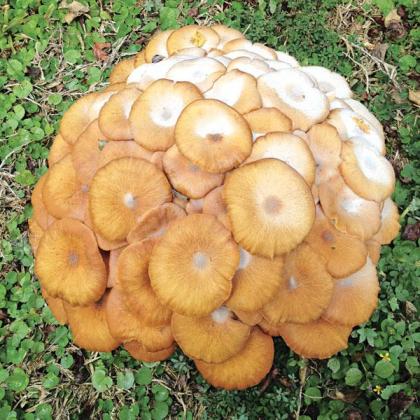
By Rick Bogren rbogren@agcenter.lsu.edu
Many homeowners and commercial landscapers are noticing clusters of honey-colored mushrooms in their landscapes. These mushrooms are fruiting bodies of Armillaria root rot caused by the species of the fungus Armillaria, said LSU AgCenter plant pathologist Raj Singh.
This destructive disease attacks a wide variety of woody ornamental shrubs and trees, Singh said. Common host plants include roses, camellias, azaleas, crape myrtles, bottle brush, Confederate jasmine, Chinese elms, oaks, pines, Leyland and Italian cypress, apples, peaches and pecans.
The disease is generally attributed to the fungus Armillaria mellea; however, several different species of Armillaria are capable of causing root rot. In the Southeast, Armillaria tabescens is primarily responsible for causing the disease.
Disease symptoms are similar to those caused by other root rot pathogens, Singh said. Infected plants wilt, rapidly decline and eventually die. Leaves turn yellow and the plants defoliate. In some hosts species, all the leaves turn brown.
A white fungal growth underneath the bark at the base of the stem and the roots can be easily seen by scraping of the bark. In severely infected shrubs or trees, the growth extends into the crown region and even few feet up on the trunk.
The mushrooms commonly appear at or near the base of infected plants, Singh said.
The soil-borne fungal pathogen is normally associated with hardwood forests and may survive in the soil on infected roots for several years.
The disease can be more of a problem in urban landscapes that were previously wooded, Singh said. The pathogen becomes active when roots from a new tree or shrub come in contact with old infected roots.
The disease spreads from one plant to another through root-to-root contact or by the fungus growing through the soil by means of fungal structures called rhizomorphs, he said.
The disease has no cure. “Once a host plant is infected and the fungus is established, little can be done to save it,” Singh said.
Although no chemicals are available to control this disease, some management practices may help either avoid or reduce its impact.
Start with disease free healthy plants, and do not plant them too deep, Singh said.
Water plants thoroughly and deeply, he said. Only water enough to avoid drought stress because continuously wetting the base and crown region of the plants favors the growth of the fungal pathogen.
“Don’t mound mulch around the base of the plant and keep the crown region dry,” Singh said.
When planting, completely remove and discard old plants suspected to be infected with the pathogen, Singh said. Removing stumps and roots along with a significant amount of soil on previously infected sites may help reduce the infectious material.
Avoid planting susceptible hosts in the same locations where infected plants previously were.
Suspected host plants infected with A. tabescens can be submitted to the Plant Diagnostic Center for confirmation. More information is available online at www.lsuagcenter.com/plantdiagnostics.
